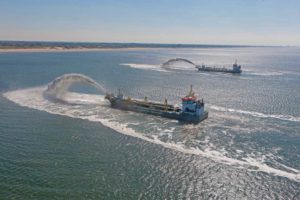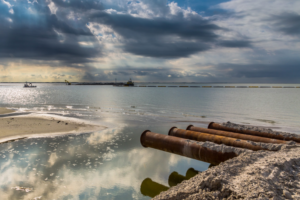As a result of continued challenging market conditions in the offshore sector, Royal Boskalis Westminster has recorded lower revenue in the first quarter. While the orderbook ncreased, pressure on profitability persits.
At the release of the 2016 annual results Boskalis announced that the market picture for the coming period would be characterized by continued lower volumes of work and pressure on both utilization levels and margins. The situation in the first quarter of 2017 met the company‘s expectations. Compared to the same period last year revenue declined at virtually stable fleet utilization rates. Weak market conditions resulted in a considerably lower result, particularly at Offshore Energy.
New dredging projects in Oman and India

Revenue at the Dredging & Inland Infra division declined slightly compared to the quarterly average achieved last year against a lower average margin. Given the circumstances, the utilization rate of the hopper fleet was good and slightly higher than the average utilization rate in 2016. The utilization rate of the cutter fleet was good in the first quarter following an extremely quiet 2016.
The order book of the division increased compared to the end of 2016. Notable new projects contracted include the development of the port of Duqm (Oman), the deepening and widening of the access channel to Jawaharlal Nehru Port in Mumbai (India), port activities in Brazil and Australia and an extension of the Fox River cleanup project in the United States.
Wind activities contribute well
At Offshore Energy there was a decline in both revenue and the result in the first quarter, in line with expectations. The contracting part of the division including Installation & Intervention and the offshore wind activities contributed well with projects in progress and positive financial settlements from previously completed projects. The offshore activities acquired from VolkerWessels in mid-2016 made a significant contribution with cable-laying projects in progress such as Galloper and Wallney.
At Transport & Marine Services the Aasta Hansteen and Mariner projects made a significant contribution to revenue. At Subsea Services the utilization rate of the vessels was low and this could only partly be offset by the deployment of vessels at offshore wind farm projects and unexploded ordnance disposal projects in Europe. The Offshore Energy order book was stable compared to the end of 2016.
Pressure on utilization rates and margins in the coming period
The market in general has not changed substantially since the release of the 2016 annual results and will be characterized by lower volumes of work and pressure on utilization rates and margins in the coming period. In view of the favorable development of the order book at Dredging & Inland Infra, Boskalis expects a large part of the fleet to be utilized in 2017, albeit at lower margins than in previous years.

At Offshore Energy Boskalis’ outlook remains unchanged. The completion of long-term contracts from previous years means increased dependence on the spot market (services), where the pressure on margins in the services part of the market continues to be considerable.
To respond to these market developments Boskalis launched a fleet rationalization and cost reduction program last year. A large part of the fleet rationalization program was already carried out in 2016 in addition to impairment charges related to part of the offshore fleet and associated goodwill. The final part of the cost reduction program is aimed at lowering costs at head office. The conclusions of the study will be announced soon.


















